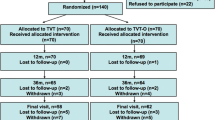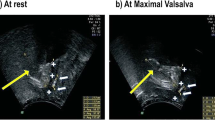Abstract
Following the success of the tension-free vaginal tape (TVT), there has been considerable interest in technique modifications such as the transobturator approach for implant placement. We attempted to elucidate possible anatomical and clinical differences between the two methods in a retrospective cohort study. One hundred and fourteen women who had undergone TVT or Monarc implantation were assessed by or under the supervision of the senior author, with identical tensioning technique. They were followed up by an interview, uroflowmetry, and translabial 3D ultrasound. There were significant differences for patient satisfaction (P=0.013), subjective overall cure/improvement (P=0.0018), and the symptom of poor stream (P=0.03), all favoring the Monarc group. On imaging Monarc tapes appeared more proximal at rest (P=0.006) and Valsalva (P=0.002) and remained further from the symphysis pubis on Valsalva (P=0.01). At 9 months follow-up, there was no significant difference as regards to cure rates for stress incontinence between the two suburethral slings. Monarc tapes are located more proximally and may be less obstructive, judging from a lower incidence of symptoms of voiding dysfunction. Patient satisfaction and overall subjective cure/improvement were higher after Monarc. In summary, the Monarc is an effective TVT alternative, achieving cure of stress incontinence by similar means. It may be less obstructive, resulting in improved patient satisfaction.


Similar content being viewed by others
References
Nilsson C, Falconer C, Rezapour M (2004) Seven-year follow-up of the tension-free vaginal tape procedure for treatment of urinary incontinence. Obstet Gynecol 104(6):1259–1262
Ward K, Hilton P (2002). Prospective multicentre randomised trial of tension-free vaginal tape and colposuspension as primary treatment for stress incontinence. Br Med J 325(7355):67
Dietz HP, Foote AJ, Mak HL, Wilson PD (2004) TVT and Sparc suburethral slings: a case-control series. Int Urogynecol J 15(2):129–131
Lim YN, Muller R, Corstiaans A, Dietz HP, Barry C, Rane A (2005) Suburethral slingplasty evaluation study in North Queensland, Australia: The suspend trial. Aust NZ J Obstet Gynaecol 45(1):52–59
Glavind K, Sander P (2004) Erosion, defective healing and extrusion after tension-free urethropexy for the treatment of stress urinary incontinence. Int Urogynecol J 15(3):179–182
Delorme E, Droupy S, de Tayrac R, Delmas V (2004) Transobturator tape (Uratape): a new minimally-invasive procedure to treat female urinary incontinence. Eur Urol 45(2):203–207
Dietz HP (2004) Ultrasound imaging of the pelvic floor. Part I: two-dimensional aspects. Ultrasound Obstet Gynecol 23(1):80–92 (Review, 86 refs)
Dietz HP, Mouritsen L, Ellis G, Wilson PD (2003) Does the tension-free vaginal tape stay where you put it? Am J Obstet Gynecol 188(4):950–953
Dietz H, Barry C, Lim Y, Rane A (2005) Two-dimensional and three-dimensional ultrasound imaging of suburethral slings. Ultrasound Obstet Gynecol 26:175–179
Dietz HP, Vancaillie P, Svehla M, Walsh W, Steensma AB, Vancaillie TG (2003) Mechanical properties of urogynecologic implant materials. Int Urogynecol J 14(4):239–243
Dietz HP, Wilson PD, Gillies K, Vancaillie TG (2000) How does the TVT achieve continence? Neurourol Urodyn 19(4):393–394
Dietz HP, Wilson PD (2004) The ‘iris effect’: how two-dimensional and three-dimensional ultrasound can help us understand antiincontinence procedures. Ultrasound Obstet Gynecol 23(3):267–271
Author information
Authors and Affiliations
Corresponding author
Rights and permissions
About this article
Cite this article
Dietz, H.P., Barry, C., Lim, Y. et al. TVT vs Monarc: a comparative study. Int Urogynecol J 17, 566–569 (2006). https://doi.org/10.1007/s00192-006-0065-2
Received:
Accepted:
Published:
Issue Date:
DOI: https://doi.org/10.1007/s00192-006-0065-2




